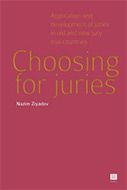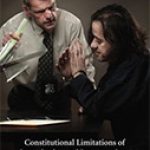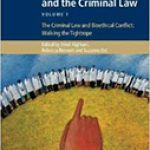Choosing for Juries: Application and Development of Juries in Old and New Jury Trial Countries

Author: Nazim Ziyado
Publisher: Antwerp, BE: Maklu, 2013. 270p.
Reviewer: Randolph N. Jonakait | November 2013
Choosing for Juries: Application and Development of Juries in Old and New Jury Trial Countries traces the development of the English and Russian jury systems in order to extract lessons for a possible jury system in Azerbaijan. This is a narrow scope, but even so, the book presents information on how jury systems vary, and that can be of interest to those concerned with juries.
In England, civil juries are almost never used, and, according to the author Nazim Ziyadov, jury trials in criminal matters are decreasing. Juries are selected without any voir dire, and peremptory challenges are forbidden. Consequently, as the author notes, “[r]andom selection of juries is the main principle in the English legal system.” (p. 75)
England also does not require unanimity for a jury verdict. If the jurors are not unanimous after about two hours of deliberation, a verdict of ten to two can be returned, and today “around 20% of all cases are reached via” a non-unanimous verdict. (79)
Russia, which had a jury system from 1864 through 1917, instituted juries again in 1993. The parties can ask questions of the potential jurors in a pool, challenge for cause, and exercise two peremptory challenges. If more than fourteen still remain, the first twelve become jurors with the next two designated alternates.
Russian trials and the role of the jurors in them, however, differ from that in England and America. Russian criminal “investigations are conducted with the old inquisition oriented rules and procedures.” At trial “the presiding judge changes his role to that of a neutral arbiter,” while the parties first present the evidence and examine the witnesses. The judge, and the jurors, can ask questions after the parties have finished their examination. This, Ziyadov states, “creates an adversarial climate,” but this adversarial procedure is not fully formed, for “defense lawyers are still hesitant in gathering evidences and playing an active role in the process.” (136-37.)
The Russian jurors do not return a general verdict but answer “a series of questions including three main questions (whether the crime was committed, whether the crime was committed by the accused and his/her guilt in committing this crime.)” (106) Other questions may also be asked that could affect mitigation or aggravation. The jurors first deliberate for three hours trying to reach unanimity, but if all do not agree, a vote is taken. For conviction, at least seven of the jurors must answer the three main questions affirmatively while six negative answers on any one of those questions results in an acquittal.
Modern Azerbaijan, which was under Russian and Soviet control from the nineteenth century until its independence in 1991, has never used a jury system. A law now does provide for juries, but it is not to take effect until all judicial reforms have been completed. As Ziyadov notes, this vague mandate makes it unclear when, if ever, Azerbaijan will have a jury system.
According to this law, the local executive must draw up a list of residents eligible to be jurors, and jury panels are to be selected from these lists. The parties can ask questions of the potential jurors and challenge for cause. With at least 22 potential jurors remaining, the parties can each exercise two peremptory challenges. From the remaining group, twelve are selected at random for the jury with another two randomly picked to be alternates.
Jurors are asked to determine whether the accused is guilty of the charged crime. Deliberations must be at least three hours, but not more than twenty-four. Unanimity is not required. Six not-guilty votes result in an acquittal, while seven are required for a conviction.
The jury’s power, however, goes beyond just the determination of guilt. The jurors are told that if they return a guilty verdict, they have a right to ask for leniency. If they do, the judge must follow the leniency finding by setting the punishment from the crimes classified one level below that for the convicted crime.
Ziyadov’s examination of the English and Russian jury system leads him to his basic point–juries acquit more than judges do. For example, he contends that nearly all criminal defendants were convicted by Russian judges before the introduction of juries in the nineteenth century, but with a jury system, the conviction rate dropped to about 75%. (90-91) While the author recognizes that juries, by allowing for public participation, can enhance the legitimacy of criminal justice, he primarily sees the importance of jury trials in limiting governmental power by the increase in acquittals. The state in initiating a prosecution wants the matter “concluded with a conviction. Jury trials, more precisely jury acquittals, interfere in such strategies, and as a consequence, the government loses its opportunity to control prosecutions of particular cases. . . . Jury acquittals and restriction of government control over case outcomes are the main factors that stimulate jury development in any country.” (200)
The result is a pushback by the government to limit jury trials. Although many reasons may be offered for the limitations–jury trials are too expensive, some cases are too complex for juries, some cases such as national security prosecutions are too sensitive for juries–the real reason for confining juries seems to be the increased acquittal rate. “In practice, acquittals delivered by juries may give rise to governments imposing limitations on this mode of trials.” (187)
From his study, Ziyadov draws two conclusions about the consequences if his native Azerbaijan were to institute a jury system. “[T]here may be a quality-enhancing effect. . . . [T]he increased acquittal rates . . . compel the government to improve the quality of dossier brought before the court and the work of investigation and prosecution authorities. . . . Second, there is counter-reform effect of jury trials. Here, the government . . . may initiate counter-reforms in attempt to limit the jurisdiction of jury trials and to exclude cases in which it has a political interest.” (251)
Randolph N. Jonakait, Professor, New York Law School


